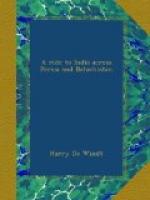The ride from Kashan had been pleasant enough. No snow was yet visible, save in the ravines, and the extreme summits of a chain of low rocky hills, of which we commenced the ascent a couple of hours or so after leaving Kashan. Half-way up, however, it became more difficult, the path being covered in places with a thick coating of ice—a foretaste of the pleasures before us. Towards the summit of the mountain is an artificial lake, formed by a strong dyke, or bank of stonework, which intercepts and collects the mountain-streams and melted snows—a huge reservoir, whence the water is let off to irrigate the distant low plains of Kashan, and, indeed, to supply the city itself. The waters of this lake, about fifteen feet deep, were clear as crystal, the bottom and sides being cemented.
This reservoir was constructed by order of Shah Abbas, who seems to have been one of the wisest and best rulers this unfortunate country has ever had, for he has certainly done more for his country than Nasr-oo-din or any of his stock are likely to. Pass a finer caravanserai than usual, travel a better road, cross a finer bridge, and interrogate your Shagird as to its history, and you will invariably receive the answer, “Shah Abbas.” At the village of Khurood, a huge caravanserai (his work) lies in ruins, having been destroyed seven or eight years ago by an earthquake. Several persons were killed, the shock occurring at night-time, when the inmates were asleep.
The post-house at Khurood was cold, filthy, and swarmed with rats—an animal for which I have always had an especial aversion. Towards midnight a Persian gentleman arrived from Kashan—a mild, benign-looking individual, with a grey moustache and large blue spectacles. The new-comer, who spoke a little French, begged to be allowed to join us on the morrow, as he was in a hurry to get to Ispahan. Notwithstanding Gerome’s protestations, I had not the heart to refuse. He looked so miserable and helpless, and indeed was, as I discovered too late next day. Our new acquaintance then suggested sending for wine, to drink to the success of our journey. At this suggestion Gerome woke up; and seeing that, in my case, the rats had successfully murdered sleep, I gladly agreed to anything that would make the time pass till daylight. A couple of bottles were then produced by the postmaster; but it was mawkish stuff, as sweet as syrup, and quite flavourless. Gerome and the Persian, however, did not leave a drop, and before they had finished the second bottle were sworn friends. Although wine is forbidden by the Mohammedan faith, it is largely indulged in, in secret, by Persians of the upper class. I never met, however, a follower of the Prophet so open about it as our friend at Khurood. The wine here was from Ispahan, and cost, the Persian told us, about sixpence a quart bottle, and was, in my opinion, dear at that. Shiraz wine is perhaps the best in Persia. It is white, and, though very sweet when new, develops, if kept for three or four years, a dry nutty flavour like sherry. This, however, does not last long, but gives place in a few months to a taste unpleasantly like sweet spirits of nitre, which renders the wine undrinkable. With proper appliances the country would no doubt produce excellent vintages, but at present the production of wine in Persia is a distinct failure.




